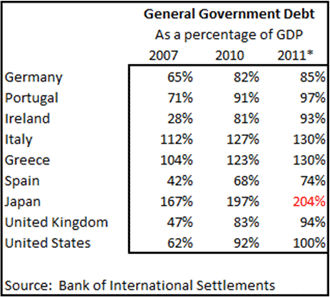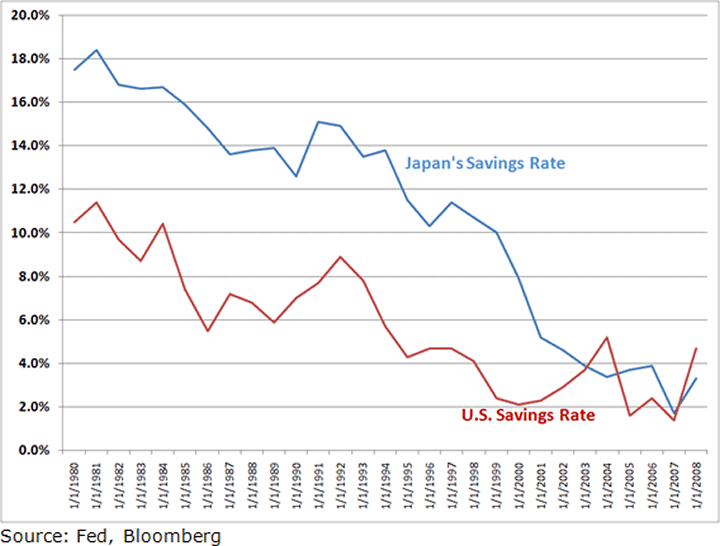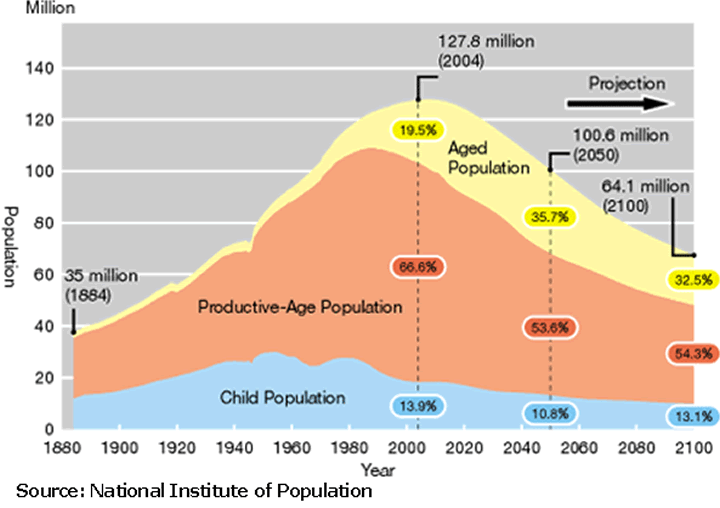Japan The Sleeping Sovereign Debt Crisis Giant
Interest-Rates / Global Debt Crisis May 15, 2010 - 10:03 AM GMTBy: Bryan_Rich
 Over the course of this year in my Money and Markets columns I’ve presented some compelling reasons why the euro zone and the euro were in for a life threatening crisis. And despite the general consensus along the way that the problems in Greece were contained and that dips in the euro should be bought, I maintained that the euro was in a no-win situation.
Over the course of this year in my Money and Markets columns I’ve presented some compelling reasons why the euro zone and the euro were in for a life threatening crisis. And despite the general consensus along the way that the problems in Greece were contained and that dips in the euro should be bought, I maintained that the euro was in a no-win situation.
Then last week, I suggested that because of the systemic threats represented by the PIIGS countries, Germany and the ECB had no choice but to go all-in to try to save the monetary union.
And last weekend, that’s exactly what they did!
They went all-in, throwing massive funds and dangerous guarantees at the problems, and printing money to support it.
Make no mistake. This is not a bailout. A bailout implies that their response is a problem solver. Not so. Their response is a desperate attempt to stabilize what was clear to European officials … a death spiral of the 11-year old European monetary union.
So what’s next?
One thing is for certain: The sovereign debt crisis will not stop in its tracks.
With the rule book in Europe thrown out like last week’s fish, the euro is in devaluation mode and so is the debt of all euro members. When it’s all said and done, likely years from now, the euro may exist in name, but it will be composed of different members and different rules … i.e. a new currency with an old name.
Now, the focus turns to the UK, the holder of the biggest budget deficit of the G-7 world and the most rapidly deteriorating debt load since the financial crisis of 2008 unraveled.
But I’ve already warned about the UK as the next wobbly domino.
Today, I want to go into more detail about the country that could prove to be the BIGGEST domino to fall … with a gigantic global quake.
Japan, in Trouble …
Take a look at the table below. Notice the aggressive growth of debt across nine advanced countries since the financial crisis and global recession set-in. Also notice which country holds the most government debt in the world. By far — it’s Japan.

In looking at this table, it’s no secret how important it is for leadership in these countries to demonstrate a credible plan to reduce deficits and growing debt loads. All of which was a result of their massive policy responses to the near global depression.
The key word in the above paragraph is “credible.” That’s where Japan falls short.
The Bank of International Settlements (BIS) said in a recent report on the growing debt problems,
“As frightening as it is to consider public debt increasing to more than 100 percent of GDP, an even greater danger arises from a rapidly ageing population.”
And within that statement are two of the three fundamentals in the Japanese economy that have it between a rock and a hard place, making a fix hard to imagine.
Fundamental Problem #1— Declining Savings Rate
As I showed you earlier, Japan is approaching 200 percent of GDP … double what the BIS considers frightening. Moreover the BIS projects, under its best case scenario, that debt could shoot up to more than 400 percent by 2040.
So how will Japan finance it?
Now, here’s where Japan runs into trouble …
Japan has historically been a nation of savers. The savings rate in the 80s and early 90s had been steadily over 10 percent, higher than any other developed country. That has allowed the Japanese government to sell nearly all of its bonds to its citizens and institutions … to the tune of 94 percent of total outstanding public debt.
But since the economy in Japan went into stagnation in the 90s and given that interest rates for 15 years have hovered around zero, the savings attitudes in Japan have shifted. In fact, the savings rate is now lower than in the U.S. — a nation considered grossly addicted to spending, not saving.
Here’s the chart on personal savings in Japan …

Now, look at the next chart, and you’ll see …
Fundamental Problem #2— Declining Population
While savings rates have been declining, so has the population in Japan, putting more pressure on the absolute quantity of savings. And it’s only expected to get worse. The projection for Japan’s population shows a big fall over the coming decades due to its ageing demographic.

And finally there’s …
Fundamental Problem #3— Non-Competitive Interest Rates
With debt expected to keep growing and revenues and savings expected to decline, Japan will have to turn to the international markets to find buyers of its debt to keep its economy breathing.
But there’s a problem with that scenario: Japan’s interest rates don’t remotely match the risk!
Japan’s 10-year debt pays just 1.3 percent. Apparently that was enough for loyal Japanese investors. But that won’t cut it for attracting international capital. Debt in other competitive advanced economies, like Europe and the U.S. are in the 3 percent to 4 percent range right now.
So what’s Japan’s ticket out?
A Currency and Debt Devaluation
As I said last week, financial crises and sovereign debt crises typically go hand in hand. As do sovereign debt crises and currency devaluations.
In a world where debt has grown dramatically across the globe and economies remain fragile and vulnerable, we’re entering a period where countries will begin competing to weaken their currencies.
Europe is already underway by weakening the euro. The UK is likely next. And then, given the fundamental outlook I just laid out for you, Japan’s yen could be in for a huge plunge.
As for the dollar, the U.S. faces all of the vulnerabilities from bloated debt and deficits. But in a world crisis, capital has to flow somewhere, and that will keep U.S. debt in demand … and the dollar too.
Regards,
Bryan
This investment news is brought to you by Money and Markets. Money and Markets is a free daily investment newsletter from Martin D. Weiss and Weiss Research analysts offering the latest investing news and financial insights for the stock market, including tips and advice on investing in gold, energy and oil. Dr. Weiss is a leader in the fields of investing, interest rates, financial safety and economic forecasting. To view archives or subscribe, visit http://www.moneyandmarkets.com.
© 2005-2022 http://www.MarketOracle.co.uk - The Market Oracle is a FREE Daily Financial Markets Analysis & Forecasting online publication.



